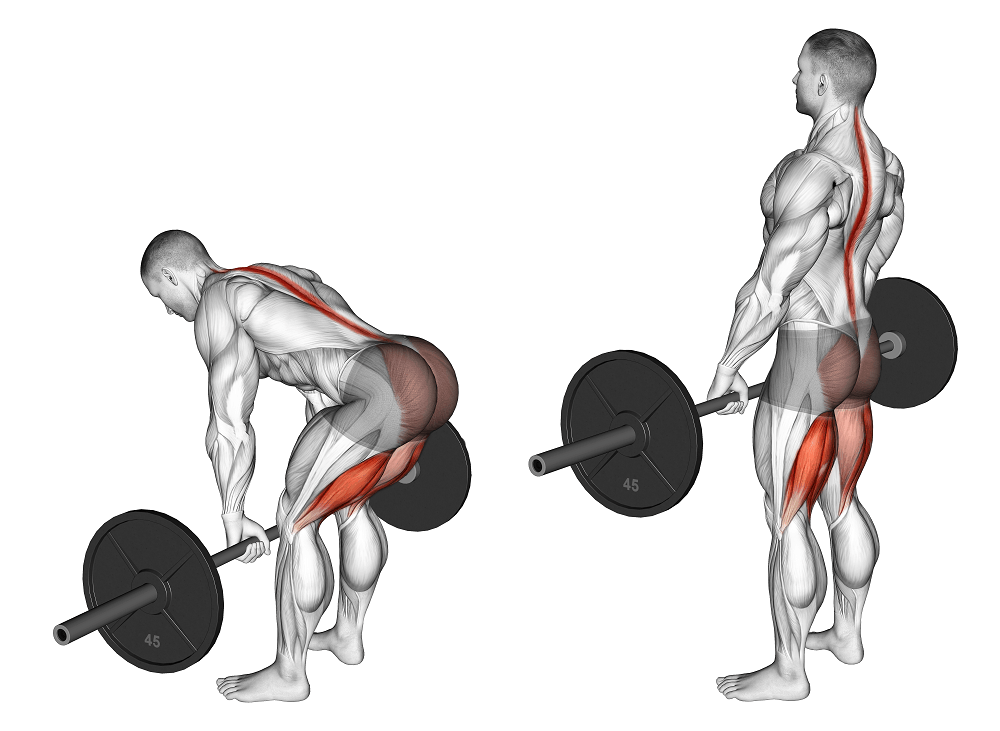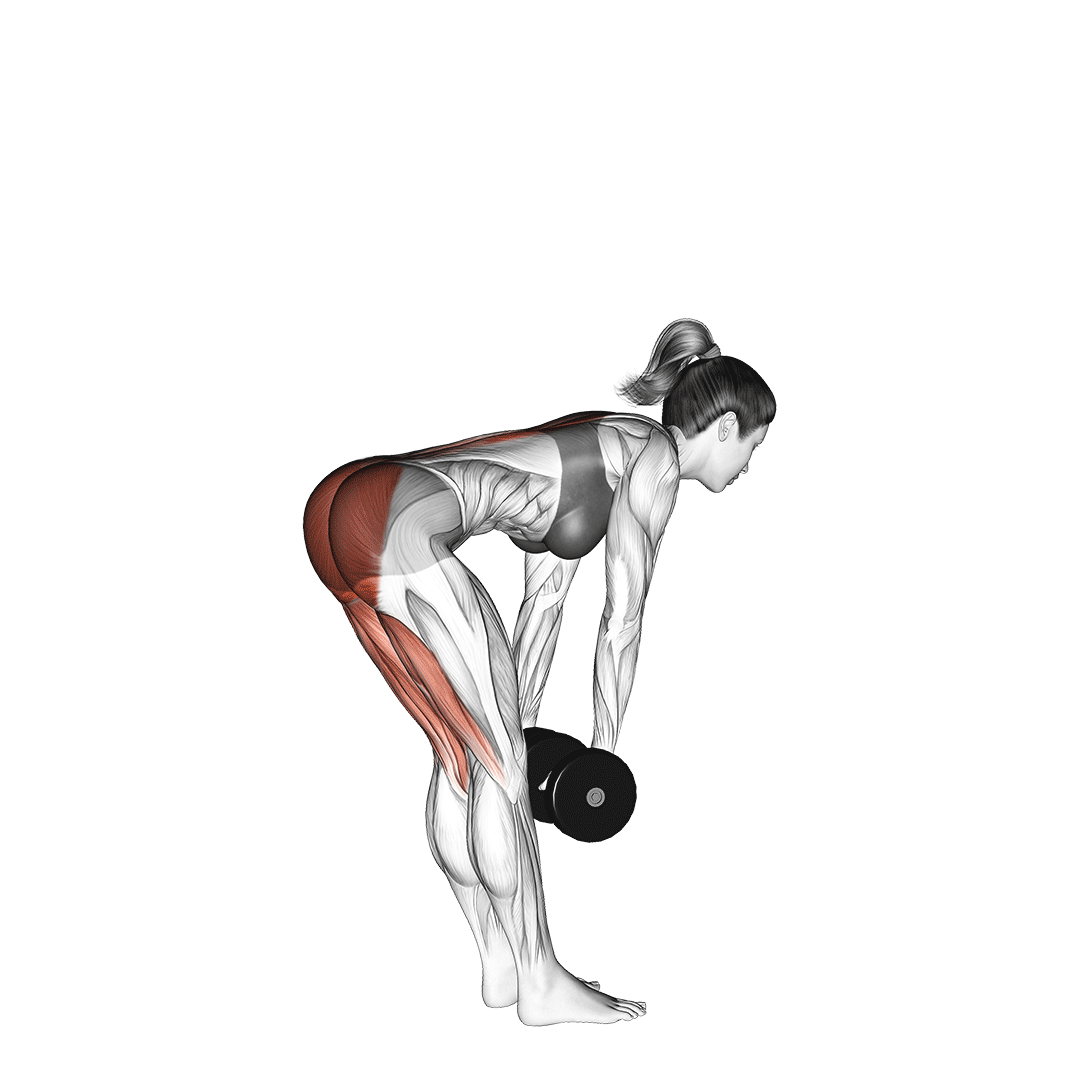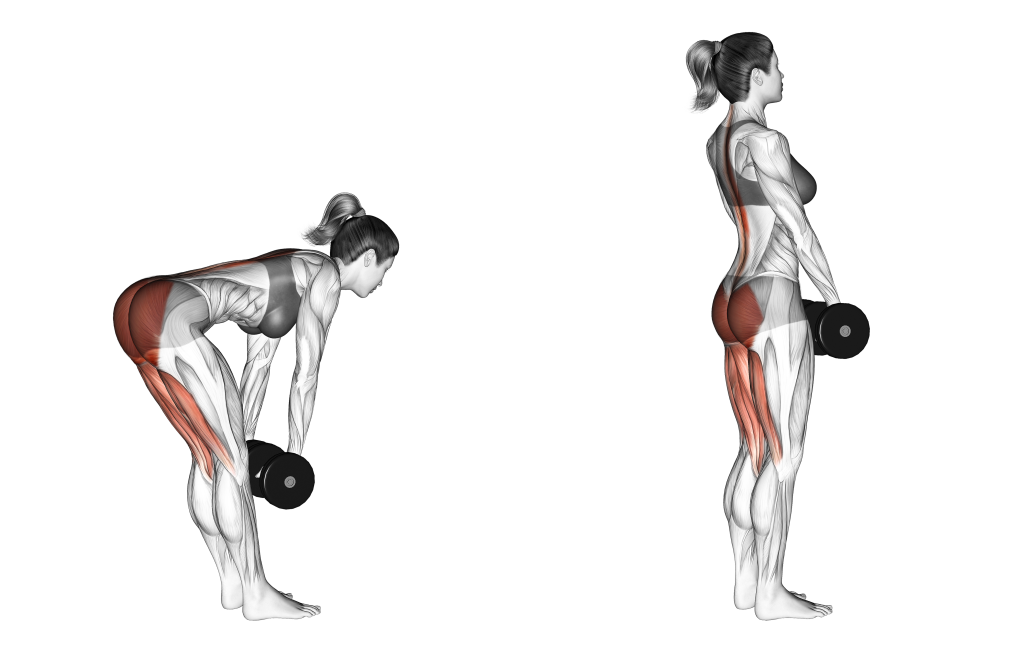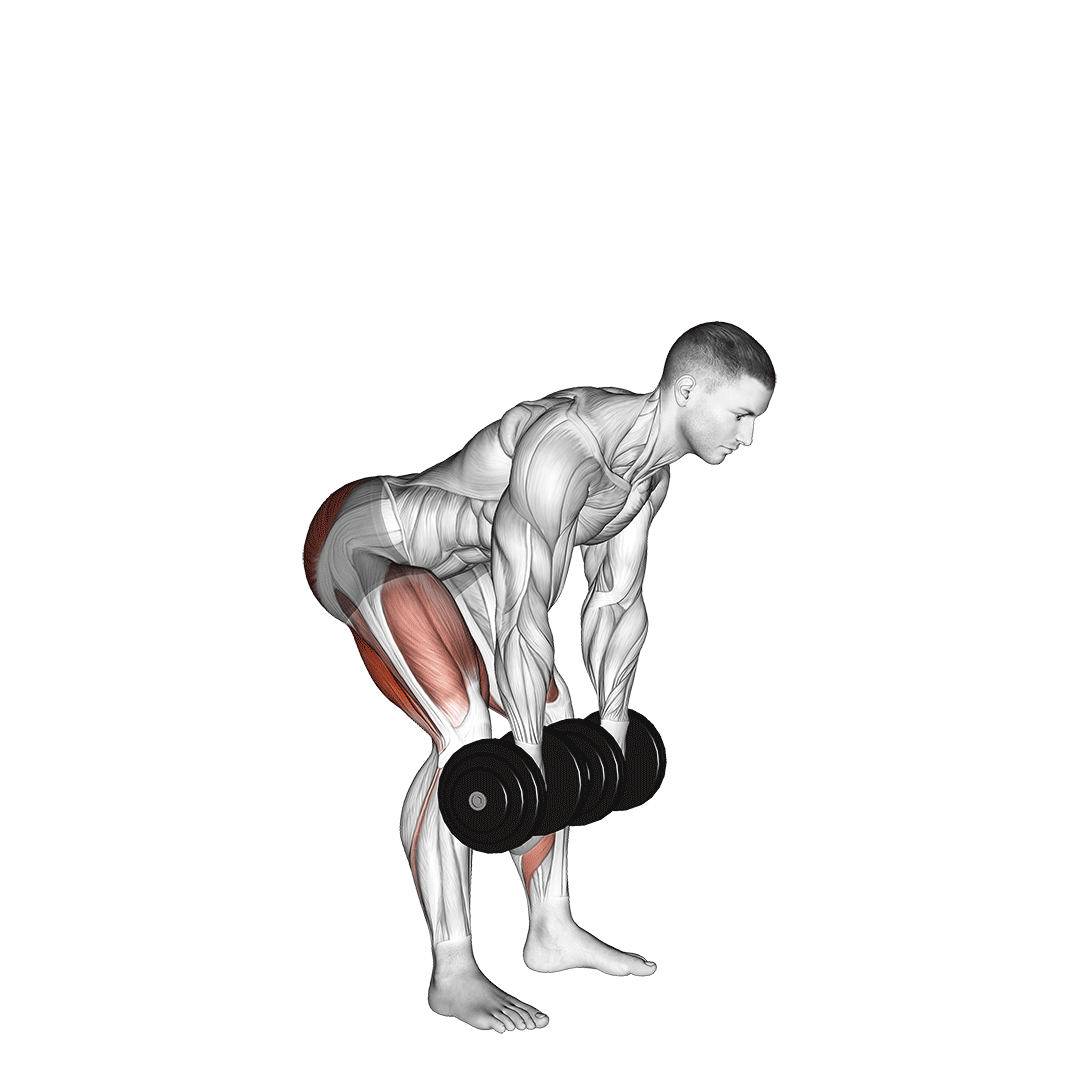Stiff Legged Deadlifts With Dumbbells: Benefits, Muscles Worked, and More
Stiff legged deadlifts are a classic exercise among all kinds of weightlifters - one that may be taken a step further by swapping out the traditional barbell with a pair of dumbbells instead.
Regardless of what sort of equipment is used, stiff legged deadlifts are exceptional for building up muscle mass and strength along the posterior chain and the lower section of the back.
If you’re just looking for the cliff notes; the dumbbell stiff legged deadlift is a heavy lower body exercise primarily employed as the main source of posterior chain training stimulus in a workout. It involves moving a significant amount of weight for a relatively small amount of volume per set, and requires at least an intermediate level of familiarity with resistance exercise to be performed safely.
What are Stiff Legged Deadlifts?
Stiff legged deadlifts are a multi-joint compound exercise performed for the purposes of building muscle mass and strength in the posterior chain and lower back.

While they are conventionally done with the use of a barbell and set of weight plates, lifters who wish to achieve a better distribution of weight can use a pair of dumbbells instead.
Stiff legged deadlifts are most often programmed as the primary compound exercise in strength training workouts, but can also help round out posterior chain training volume when paired with quad-dominant compound movements like the hack squat or front squat.
Who Should Do Dumbbell-Based Stiff Legged Deadlifts?
Dumbbell stiff legged deadlifts are somewhat more forgiving than their barbell counterparts, and as such are accessible to novice level lifters, so long as additional attention is paid to form.
Ideally however, intermediate level lifters seeking simultaneous strength and mass developments of the posterior chain muscles are the best suited to performing the exercise.
How to do Dumbbell Stiff Legged Deadlifts
To perform a repetition of the dumbbell stiff legged deadlift, the lifter will place their feet shoulder-width apart with a pair of dumbbells held in their hands, grip in a pronated or neutral orientation.

Contracting the core and ensuring that the lower back remains flat throughout the repetition, the lifter will bend at the hips and bend the knees in as minimal a degree as possible as they lower the dumbbells towards the floor.
Once the hamstrings and glutes are at the limit of their mobility, the lifter will slowly reverse the motion by contracting their posterior chain muscles, drawing themselves back up to a standing position as they push their pelvis forwards.
At this point, the lift is considered to be complete.
The entire point of the exercise is to minimize movement in any manner that does not include the hamstrings and glutes - this means bending at the waist, knees, or with any other part of the body apart from the hips.
Doing so will not only reduce the effectiveness of the exercise, but also potentially injure the lifter.
Muscles Worked by Dumbbell Stiff Legged Deadlifts
Stiff legged deadlifts are classified as a compound exercise, meaning that more than a single muscle is activated at once. These muscles are separated by the degree to which they are recruited, and whether it is in a dynamic or static manner.

Muscles worked to a greater or lesser dynamic degree are referred to as primary and secondary mover muscles respectively, whereas those activated in solely a static capacity are referred to as stabilizer muscles.
Primary Mover Muscles
For stiff legged deadlifts, the primary mover muscles are those of the hamstrings muscle group and the muscles of the glutes.
In particular, it is the hamstrings that are given the greatest focus during the exercise, as they are contracted to the fullest extent throughout the entirety of each repetition - making the stiff legged deadlift a hamstring-dominant movement.
Secondary Mover Muscles and Stabilizers
Other muscle groups recruited by the stiff legged deadlift are the erector spinae and other muscles of the lower back - as well as those of the quadriceps, calves and core, of which are recruited solely in a stabilizing capacity.
Benefits of Doing Dumbbell Stiff Legged Deadlifts
Resistance training in all forms is beneficial - but the dumbbell stiff legged deadlift takes things a step further by acting as the perfect tool for posterior chain training.
Even in cases where the muscles of the lower body receive plenty of volume, the stiff legged deadlift can nonetheless play a vital role in any athlete’s training program, as its benefits are not solely constrained to building muscle mass alone.
Fantastic Posterior Chain Muscle Growth
The entire reason for performing stiff legged deadlifts is training the muscles of the posterior chain - that is to say, the glutes and hamstrings are trained to a highly effective level by the exercise.
Lifters seeking to build up mass and strength in these often-neglected muscle groups will see the most benefit by performing dumbbell stiff legged deadlifts alongside similar exercises that also target the same muscles, such as the machine leg curl or even good mornings.
Reinforces Posterior Chain Neurological Recruitment Pathways
Otherwise known as the mind-muscle connection; most lifters possess poor posterior chain recruitment simply due to the fact that they have not performed enough volume to become consciously skilled at it.
Lifters with trouble at the bottom depth of their squat, athletes who suffer from poor jump height or even ordinarily sedentary individuals will all benefit from the mind-muscle reinforcement seen with stiff legged deadlifts, of which will allow them to better recruit the muscles of the glutes and hamstrings in a conscious manner.
Builds Lower Body Explosiveness and Power
The muscles of the posterior chain (particularly the glutes) are vitally responsible for much of the lower body’s explosiveness and power. They play a vital role in explosive movements like jumping or sprinting, and as such must be trained appropriately if muscular power is within the scope of the lifter’s training goals.
The stiff legged deadlift offers not only mass and strength developments of the posterior chain, but can also build up the rate of force development that such muscles are capable of - or what is otherwise known as explosiveness.
In order to build the most explosiveness and power with stiff legged deadlifts, lifters should seek to maximize tension in their posterior chain with each repetition, and to balance out volume with resistance within their program.
Acts as Progression Step to Other Posterior-Focused Deadlift Variations
Lifters who wish to eventually perform more advanced deadlift variations like the single-leg deadlift or the Romanian deadlift may wish to first familiarize themselves with dumbbell stiff legged deadlifts, of which can help teach them important deadlift mechanics like the hip hinge and proper gluteal muscle recruitment.
In order to keep the lifter safe as they do so, it is advised to use the minimum effective amount of weight possible, and to seek out the advice of a professional athletic coach.
Carryover to Many Athletic Activities
Because the posterior chain plays such a vital role in many explosive movements, regular performance of the dumbbell stiff legged deadlift can lead to significant improvements in an athlete’s physical performance - or what is otherwise known as non-specific carryover.
When incorporated into an athletic training program, athletes may wish to pair the stiff legged deadlift with other lower-body explosive exercises like the squat jump or certain types of plyometric exercise.
Dumbbell and Barbell Stiff Legged Deadlifts - Differences and Use Cases
Stiff legged deadlifts are traditionally performed with the use of a barbell, and lifters more familiar with this particular variation may find the switch to dumbbells confusing. The following are the three main differences seen between dumbbell and barbell based stiff legged deadlifts.
Weight Distribution
Performing stiff legged deadlifts with the use of a barbell allows for an easier time balancing the weight, as it is distributed over a longer space and allows each side of the body to stabilize the other.
Range of Motion
Dumbbell stiff legged deadlifts allow for a greater range of motion to be achieved because of the manner in which dumbbells are shaped, as well as the fact that they may be held in either an overhand or underhand grip on either side of the legs.
A greater range of motion equates to the hamstrings being worked to a greater degree, and as such may make the dumbbell variation superior for pure hamstring recruitment.
Energy Efficiency and Maximum Load
The barbell stiff legged deadlift can allow for a more efficient distribution of weight on account of its bilateral nature, letting the lifter load more weight and therefore better gearing the exercise towards strength in comparison to the dumbbell-based variation.
Furthermore, this will also reduce the incidence of smaller muscle groups acting as a limiting factor, such as is the case in dumbbell stiff legged deadlifts where the forearms, deltoids or trapezius may become fatigued before the primary mover muscles do.
Common Dumbbell Stiff Legged Deadlift Mistakes to Avoid
As technical as the stiff legged deadlift can be, there are nonetheless a few mistakes that are more common than others - all of which should be corrected so as to avoid an ineffective or dangerous exercise.
Rounding the Back
Just as is the case in all other deadlift variations, allowing the back to round at any point during the exercise can place the spine in jeopardy, and is generally a sign of something being critically wrong with the lifter’s deadlift execution.
For the stiff legged deadlift, this is likely due to a failure to contract the core musculature - or a simple lack of mobility in the posterior chain and lower back.
Allowing the Dumbbells to Drift
During the dumbbell stiff legged deadlift, allowing the dumbbells to drift away from the body can cause the lifter to disbalance themselves and potentially break proper form.
In order to avoid this, it is advised that the lifter keeps the dumbbells in contact with their legs throughout the entire repetition.
Fully Extending the Knees or Bending Them Excessively
The stiff legged deadlift is meant to be performed with the knees only bent enough to allow for mobility, but not enough to overly involve the quadriceps femoris.
Likewise, failing to bend the knee at all (such as by keeping them in a state of full extension) will place unneeded stress on the joints of the ankles and knees, as well as make the exercise more difficult than necessary.
Lifters should aim to perform the dumbbell stiff legged deadlift with knees that are slightly bent, but nonetheless stationary throughout the entire range of motion.
Frequently Asked Questions (FAQ)
Is the Stiff Legged Deadlift the Same as RDL?
Not at all - the stiff legged deadlift is different from the Romanian deadlift in terms of range of motion and general hinge mechanics.

The stiff legged deadlift will generally feature more emphasis on proper hip hinging, and will also require a larger range of motion.
Should Stiff Leg Deadlifts be Heavy?
Only up to a certain point.
Stiff legged deadlifts - like most other types of deadlifts - require a significant amount of weight to be truly effective. Not as much as a conventional or sumo deadlift, of course, but enough weight should be used that the muscles of the body are challenged to a significant degree.
Aiming for somewhere between 70-80% of your one rep max should be sufficient for general working set weight.
Are Stiff Legged Deadlifts Bad for Your Back?
Like all other exercises, stiff legged deadlifts are only truly dangerous when performed incorrectly. If you are not following proper form or are attempting to lift more than you are able, then it is possible that your back may become injured.
Stick to lifting a moderate amount of weight and ensure that form is followed to the letter.
Final Thoughts
Regardless of whether you’re performing the dumbbell stiff legged deadlift for mass, strength or any other goal, it is important to keep in mind that it only plays a partial role in a proper lower body workout.
The fact that the stiff legged deadlift places significant emphasis on the posterior chain means that less training stimulus is diverted towards other parts of the lower body, and further exercises must be included into the program so as to make up for this deficit.
In either case, there is no doubt that the dumbbell stiff legged deadlift is excellent at fulfilling its specific purpose, and lifters performing it with proper form will doubtless see the improvements they are looking for.
References
1. Coratella G, Tornatore G, Longo S, Esposito F, Cè E. An Electromyographic Analysis of Romanian, Step-Romanian, and Stiff-Leg Deadlift: Implication for Resistance Training. Int J Environ Res Public Health. 2022 Feb 8;19(3):1903. doi: 10.3390/ijerph19031903. PMID: 35162922; PMCID: PMC8835508.
2. Gardner, P. J. MS, CSCS; Cole, Don E.. The Stiff-Legged Deadlift. Strength and Conditioning Journal 21(5):p 7, October 1999.
